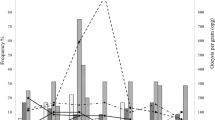Abstract
An epidemiological study with the objective to assess the prevalence of paramphistomosis in association with season, age, sex and breed was carried out in naturally infected sheep over a period of two years from February 2005 to January 2007. Gastrointestinal tract (GIT) and faecal examination were conducted monthly to monitor the seasonal occurrence of paramphistomosis. 793 sheep were examined in the first year, out of which 7.06% were positive for Paramphistomum infection. In the second year, 740 animals were investigated and 7.7% were infected. The overall prevalence of paramphistomosis was 7.3% with a mean of 56.50 ± 0.50 and 95% confidence interval (CI) (lower bound: 50.1469; upper bound: 62.8531). The prevalence of paramphistomosis through GIT examination (P = 0.593) was 7.6% at 95% CI (lower bound: −19.1186; upper bound: 57.1186) and the prevalence through faecal examination (P = 0.884) was 7.2% at 95% CI (lower bound: 5.7345; upper bound: 69.2655). Generally, season and age were the factors found to have a significant influence on the risk of paramphistomosis in sheep. The highest infection was found in the summer season (P < 0.005); lower age groups (P < 0.005) in males and in migratory (Bhakarwal) breed (P ≥ 0.005). Winter, adult animals, females and local breed reported low infection. The present study will be of great significance to understand the epidemiology of gastrointestinal helminthes of sheep initially in the resource poor communities of Himalayan region and will definitely be helpful to devise appropriate control strategies for paramphistomosis.
Similar content being viewed by others
References
Amarante, A.E.T., Bricarello, P.A., Rocha, R.A. and Gennari, S.M., 2004. Resistance of Santa Ines, Suffolk, and IIe de France sheep to naturally acquired gastrointestinal nematode infections, Veterinary Parasitology, 120, 91–106.
Chhabra, R.C. and Gill, B.S., 1975. Incidence of helminthic infections and control of amphistomiasis and fascioliasis in animals in two villages of Punjab, Journal of Research Punjab Agriculture University, 12, 184–188.
Dar, G. H., Bhagat, R. C. and Khan, M. A., 2002. Biodiversity of the Kashmir Himalaya. (Valley Book House, Srinagar — 190006, J&K), pp. 19.
Gicik, Y., Arsalan, M.O., Kara, M. and Kose, M., 2003. The prevalence of paramphistomiasis in sheep slaughtered in the Kars province, Turkey, Turk Para Dergisi, 27, 260–261.
Hassan, S.S., Kaur, K. and Juyal, P.D., 2005. Epidemiology of paramphistomosis in domestic ruminants in different districts of Punjab and other adjoining areas, Journal of Veterinary Parasitology, 19, 43–46.
Khajuria, J.K. and Kapoor, P.R., 2003. Prevalence of parasites in sheep and goats at Kathua-Jammu, Journal of Veterinary Parasitology, 17, 121–126.
Niezen, J.H., Charleston, W.A.G., Hodgson, J., Mc Kay, A.D. and Leathwick, D.M., 1996. Controlling internal parasites in grazing ruminants without recourse to anthelmintics; approaches, experiences, prospects, International Journal of Parasitology, 26, 983–992.
Odoi, A., Gathuma, J.M., Gachuiri, C.K. and Omore, A., 2007. Risk factors of gastrointestinal nematode parasite infections in small ruminants kept in small holder mixed farms in Kenya, BMC Veterinary Research, 3, 6 DOI 10.1186/1746-6148-3-6
Patel, M.D., Nauriyal, D.S., Hasnani, J.J. and Gupta, R.S., 2001. Prevalence of gastrointestinal parasitism in goats maintained under semi-intensive and field management systems, Indian Journal of Veterinary Medicine, 21, 99–101.
Rangel-Ruiz, L.J., Albores-Brahms, S.T. and Gamboa-Anguilar, J., 2003. Seasonal trends of Paramphistomum cervi in Tabasco, Mexico, Veterinary Parasitology, 116, 217–232.
Soulsby, E.J.L., 1982. Helminths, Arthropods and Protozoa of Domesticated Animals, 7th edn. (The English Language Book Society and Bailliere Tindall, London).
Waller, P.J., 1999. International approaches to the concept of integrated control of nematode parasites of livestock, International Journal for Parasitology, 29, 155–164.
Wildeus, S. and Zajac, A.M., 2005. Gastrointestinal parasitism in hair sheep and meat goat breeds grazing naturally infected pasture, Sheep and Goat Research Journal, 20, 42–46.
Yadav, A., Khajuria, J.K. and Raina, A.K., 2006. Seasonal prevalence of gastrointestinal parasites in sheep and goats of Jammu, Journal of Veterinary Parasitology, 20, 9–12.
Author information
Authors and Affiliations
Corresponding author
Rights and permissions
About this article
Cite this article
Tariq, K.A., Chishti, M.Z., Ahmad, F. et al. The epidemiology of paramphistomosis of sheep (Ovis aries L.) in the north west temperate Himalayan region of India. Vet Res Commun 32, 383–391 (2008). https://doi.org/10.1007/s11259-008-9046-x
Received:
Accepted:
Published:
Issue Date:
DOI: https://doi.org/10.1007/s11259-008-9046-x



